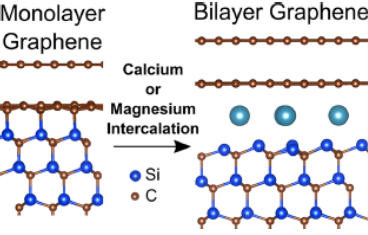

Superconducting calcium-injected graphene
Since the discovery of superconducting Caintercalated graphite (CaC6) the intercalation of epitaxial graphene on SiC(0001) with Ca has been studied extensively in order to achieve superconductivity. In this study Ca and Mg alkaline-earth elements have been injected into graphene. Using high resolution X-ray photoelectron spectroscopy (XPS) on the Soft X-ray (SXR) Beamline at the Australian Synchrotron it was demonstrated that calcium atoms unexpectedly positioned themselves near the silicon carbide surface with the formation of an additional graphene layer on top.
Our research

Comparison of monolayer graphene and bilayer graphene
Researchers from the ARC Centre of Excellence in Future Low Energy Electronic Technologies (FLEET) prepared intercalated samples in-situ and transferred them under vacuum to the XPS chamber on the SXR beamline.
The synchrotron allow the researchers to ‘tune’ the X-ray energy. This makes synchrotron XPS quite powerful compared to lab based XPS sources as one will be able to maximise the signal from a desired element and distinguish topmost atomic layers from the bulk hence gaining information from different depths in the sample investigated.
The research group managed to confirm that when calcium atoms were injected into an epitaxial graphene layer on a silicon carbide substrate they would intercalate underneath a partially bonded carbon layer on the surface of the silicon carbide instead of between the graphene layer and the substrate. This partial bonded carbon layer would then lift off and form a new layer of graphene.
The team also investigated magnesium intercalation and found that magnesium behave remarkably similar to calcium with the difference that magnesium intercalated graphene unlike calcium intercalated graphene remained stable in ambient atmosphere for a longer period of time.
Our impact
The reduction of crystallisation in the active layer by introducing a mixed acceptor is an effective way to make more robust devices which can undergo significant mechanical stress and strain without losing its efficiency. The Australian Synchrotron played a key role in the investigation of this ultra-flexible organic solar cell.